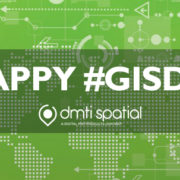Celebrating GIS Day
Did you know there is a GIS day to celebrate the impact of GIS technology around the globe? Today is GIS Day, and at DMTI Spatial we see this as a great opportunity to share our knowledge of the role Canada has played in the development of GIS as a technology that has shaped and changed our world in profound ways.
Today, 66% of enterprises rank GIS technology as critical or very important to revenue growth strategies, and many fundamental business practices–even elements of our national safety suc as assisting with emergency responsiveness and preparedness–rely on GIS technology.
What is GIS Day?
GIS Day started in 1999 as a movement launched by Esri to encourage people to learn and share knowledge about the widespread impact of GIS technology. The movement has grown over the years, and today GIS Day has a Facebook group with 18,000+ members!
GIS Day provides a forum and an opportunity for GIS experts to demonstrate the real-world applications of this amazing technology and how it makes a difference in our society. Every map has a story, and GIS Day is the time to celebrate those stories.
Canada and GIS Day
Canada’s history is rich in technological achievements, and is a pioneer in the development of GIS. Many of the methods and techniques used by GIS specialists throughout the world were developed or conceptualized by Canadians.
Here are some examples of how Canada has contributed GIS technological innovations:
- Dr. Larry Morley: Widely considered a remote sensing pioneer, Dr. Morley is remembered for starting the remote sensing program in Canada. He was the founding Chairman of the Canadian Remote Sensing Society in 1974, and in 2015 he was inducted into the Canadian Science and Engineering Hall of Fame.
- Dr. Roger Tomlinson: Known as the ‘father of GIS,’ Dr. Tomlinson worked for the Ottawa-based survey company Spartan Air Services. It was here that he conceptualized the idea of combining land use mapping with computer technology, and became central to the development and eventual applications of GIS technology.
- RADARSAT: This Canadian-based remote sensing Earth observation satellite is an advanced satellite system providing high quality, accurate images of the earth for a wide range of uses–one of which of course is integration with GIS technology.
- Geomatics: This fundamental GIS term was introduced by Michel Paradis, a French-Canadian surveyor, during a keynote address to the Canadian Institute of surveying in 1982. He argued that mapping tools would need to innovate alongside the pace of technology to truly address modern mapping needs. The phrase ‘geomatics’ became the accepted umbrella term for the tools related to mapping technologies.
GIS Technology in Canada Today
Many Canadian companies and scholars continue to push GIS technology forward, often with support of various government programs. Geospatial technology is critical to the functioning of many technologies people have become dependant on, including mapping applications, sensor technologies necessary for the Internet of Things (IoT), and Artificial Intelligence (AI).
The Canadian Geospatial Data Infrastructure (CGDI) is supported by the Canadian government, and is the source of “standards, policies, applications, and governance that facilitate the access, use, integration, and preservation of spatial data.” GeoConnections is another national program mandated to lead CGDI through the use of standards-based technologies and operation policies for data sharing and integration. This program is incredibly important, as it ensures that quality GIS technology is accessible to the people who need it.
DMTI is Canada’s Leading GIS Technology Provider!
Canadian people and companies will continue to make major contributions to the advancement of GIS technologies throughout the world. Here at DMTI we are proud contributors to Canada’s GIS past, present, and future.
Founded in 1994, we knew early on that the power of location could serve many business sectors including finance, insurance, telco, government, retail, and marketing. DMTI introduced CanMap, the first coast-to-coast digital street map in Canada! As GIS technology became more sophisticated, so did we, adding data to maps, finding unique and innovative ways to serve Canadian businesses.
Contact us today, and learn how DMTI Spatial can help your business grow!
When a whole city changes…
Providing the best data visualization products for Canada means investing in the best sources of information possible. Streetfiles, postal codes and address points are key layers and must be accurate.
DMTI’s Data Visualization Tools
DMTI identifies areas to work on ranging from new subdivisions to urbanizing rural areas. Typically, the number of changes per area ranges from a few to a few hundred.
Our team occasionally encounters a scenario where a municipality has changed so much that it appears completely different. Everything is affected — from the street name to the postal codes that provide mail to their residents and businesses.
The Case of Shawinigan, QC.
Shawinigan is a city located on the Saint-Maurice River in the Mauricie area in Quebec, Canada. The population is 50,060 as of the Canada 2011 Census as per Wikipedia and 26,230 private dwellings occupied by usual residents.
As part of our focus on Canada, we are continually updating and comparing three (3) main sources of information. This includes streets, postal codes and addresses.
Our data team compared the latest Canada Post data against the current database. We found that Shawinigan, QC – many addresses suddenly fell out due to changes.
An investigation revealed the area recently changed most of their addresses, and was planning to change more. The Canada Post data was actually showing only about half of the changes. Nearly the whole area would be affected!
We compared this finding against additional sources to fact check the changes. Our team made the city-wide changes to our data as soon as possible.
The result was some Canada Post fallout within the product. But this allowed us to deliver greater accuracy and stay aligned with the changes.
Due to the scope of the changes (an entire municipality!) – the entire data team banded together and got this update into our upcoming Aug 2016.3 data release because of how important it is to ensure our products are in alignment.
Congratulations Data Team, and thank you for your on-going commitment to data quality and currency and all of the other changes that went into this release!
Click here to learn more about how DMTI Spatial delivers complete accuracy, helping businesses get ahead of the competition.
Toronto Police Launch New Crime GIS Mapping Tool
Mapping data using visualization tools is a powerful way to engage your audience. Today’s announcement by the Toronto Police of a crime-mapping tool is a great example of an interactive, online map to further engage the public. Crime-mapping tools can help solve major crimes by being able to visualize data on a map. Here’s a snippet of the story:
“The set of tools provides interactive mapping of crime information that will give the public up-to-date locations of what’s been happening in their communities,” Ian Williams, acting manager of business intelligence and analytics, said in a release.
Interacting with GIS Data
Data growth is set to continue at a fast rate, with data growing in volume, breadth, and complexity.
Many datasets within our enterprises are capable of being mapped, but accurate geocoding, datasets and easy to use visualization tools are the key.
DMTI Spatial Data Visualization
Did you know that DMTI Spatial provides options? Our datasets cover over 97% of Canadian addresses. We update over 2,100 postal codes and 2,300 municipalities across Canada in the last 3 months alone. And this data is available for use in mapping apps as well. Our API brings high precision geocoding and address points directly into your customer solutions.
Are you struggling to implement data visualization? What challenges do you run up against in engaging your audience through mapping technologies? Click here to learn how DMTI Spatial can help.
The productive days of summer?
Many businesses think summer is the time to relax. It’s also a great time to gain a competitive advantage through location intelligence and data insights.
Your summer business strategy may consist of three (3) simple steps to gain that competitive edge:
- Look for easy access to data
- Ensure comprehensive data selection
- Better understand your risk
Look for Easy Access to GIS Data
When looking for risk related data:
- Confirm the data is available through a web service. This allows you to integrate information into your current platform such as the Purview AVM data and perils related data.
- Understand how to obtain the highest match rate between your database and data services. This helps to avoid ambiguous addressing through the use of a unique address identifier (UAID®).

Lenders using DMTI Spatial’s™ Location Hub® platform can search the national Purview web service using the UAID which is assigned to every address for Canada with roof-top precision.
Ensure Comprehensive GIS Data Selection
Teranet partnered together with DMTI Spatial to provide complimentary capabilities to shared clients. This partnership provides clients with a complete view of their data.
| Teranet | DMTI Spatial |
| Addresses | |
| Property Ownership | Flood |
| Property Valuation | Earthquake |
| Equity Estimate | Crime |
| Comparable Sales | Environmental Risk |
| Fraud Checks | Demographics |
| House Price Index (HPI) | Firmographics |
With over 15M addresses in Canada, having access to the most comprehensive risk-based information at the property level allows insurance and finance companies to generate new insights.
Understand Your Risk
With this wealth of location-based information businesses can benefit in the following ways:
- Understand the risks associated with specific geographical areas and leverage that knowledge to fine-tune pricing
- Link disparate information for real-time decision making
- Enhance portfolio analysis across the entire book of business
Summary
Take advantage of the down-time that summer offers. Evaluate your current systems and workflows and explore solutions that provide comprehensive information to help you hit the ground running in the fall.
Learn how location intelligence can help your business by contacting DMTI Spatial.
Gone fishin’… in a data lake? Predictive Analytics Launch!
Our new Predictive Analytics product launches in less than 2 weeks! As we approach this exciting milestone, we anxiously anticipate the loud ‘splash’ when LEADS (the codename for the product) finally hits the market. I use splash somewhat literally and quite purposefully, as we reside in the era of the “data lake.”
What is a Data Lake?
The buzz term data lake is progressively used to describe “a state in which all data resides in one environment and can be explored and interpreted without imposing a schema”. Martin Willcox of Teradata eloquently describes the data lake as promoting three big ideas:
- Captures data in a centralized Hadoop-based repository
- Stores data in a raw form
- Enables the breakdown of barriers that inhibit analytics
Picture yourself fishing in a small canoe in a vast open body of peaceful water. As you peer over the side of the canoe you can see clearly beneath the surface into a limitless sea. Within the waters you can see hundreds, if not thousands, of fish swimming carefree. Each fish is a different color and each fish carelessly brushes against your line. As each fish passes your fishing rod tremors, but it is not until the right fish decides to take the bait that you begin the experience of fighting for your prize.
New Insights are Coming from DMTI
Welcome to the data lake. Each fish is a new variable or piece of data you may or may not have seen before. This intelligence you have been exposed to will allow you to gain the valuable insight from a sea of information that is seemingly too difficult or disparate to collect yourself.
This is what LEADS will do. Stay Tuned!
Click here to see DMTI’s GIS Mapping software solution.
Properties, Oil and Water Don’t Mix
Oil and Water Don’t Mix. That was especially true on Wed April 8, 2015 when a tanker in the English Bay in Vancouver was reported to be leaking fuel into the surrounding waters.
The spill amount was “above the norm” but not “catastrophic.” Local residents were warned to avoid the beaches on both sides of the bay, according to CBC News,
Transport Canada has reported the following major oil spills in western Canada:
- In 1988, Vancouver Island was affected by a spill from an oil barge that lost approximately 87 tons of oil
- In 2006, a B.C. ferry sank with 240 tons of oil on board.
Gauging the impact
You can view an event zone on a map and determine exposure quickly by linking impacted addresses to your book of business with DMTI’s Location Hub® Post Event Service. Custom event reports allow you to easily share exposure information across your organization. This ensures swift action and superior customer service.
What is the impact of oil spills on property values?
A report created by the Conversations for Responsible Economic Development (CRED) reveals the following key findings:
- Both direct contamination & the perception of contamination have clear and well documented impacts
- In several documented cases, directly impacted properties lost 10-40% of their value
- The reputational impacts alone are significant – properties nearby spills will usually see a 5-8% reduction in value
- The most significant impacts are felt in the first year and usually last less than 5 years
Assessing future risk
A proposed pipeline destined to carry more oil to the Westridge terminal in Burnaby, BC would increase the number of tankers traveling through Canadian waters from 5 to 34 per month (Global News).
How can organizations prepare?
- Connect. Analyze. Act™
- Seek a solution that provides timely and advanced insight into the duration, size, impact and number of addresses affected by an event. This allows you to easily share exposure information across your organization.
- National insights in real-time
- Take advantage of an offering that delivers property level event information and other perils that may impact your book of business.
How can I learn more?
- Contact us to learn more about how you can leverage DMTI’s Location Hub® Post Event Service to stay on top of events that impact your business.









